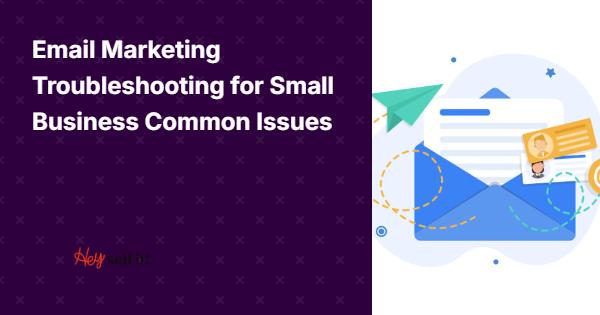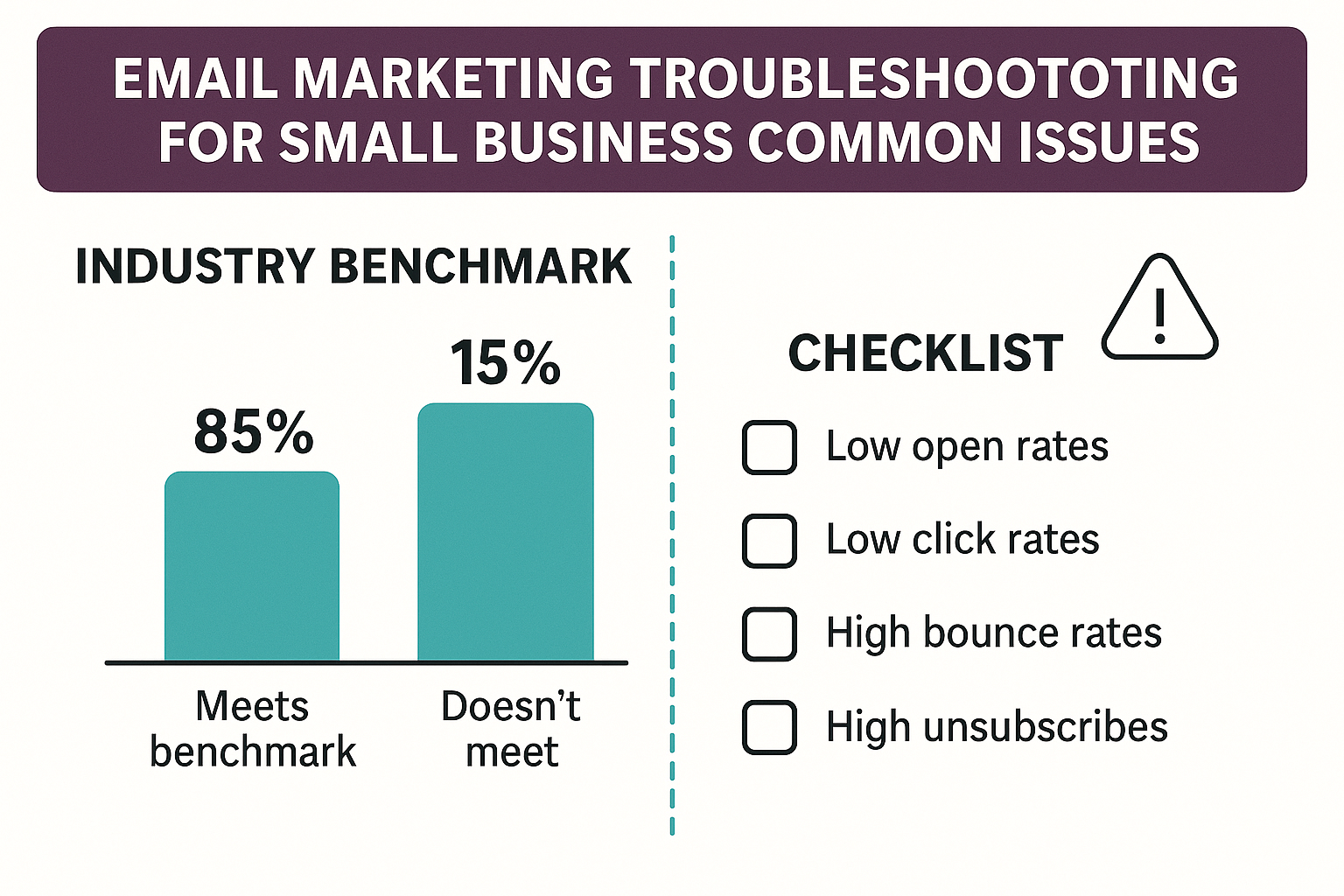Abdullah Usman
You’ve just launched what you thought was the perfect email campaign for your small business. You’ve crafted compelling subject lines, designed beautiful templates, and hit send to your carefully curated list of 2,000 subscribers. But instead of the anticipated flood of opens and clicks, you’re staring at a disappointing 8% open rate and crickets in your inbox. Sound familiar?
If you’re nodding your head right now, you’re not alone. According to recent industry data, 73% of small business owners struggle with email marketing performance, often without knowing why their campaigns are falling flat. The good news? Most email marketing issues have straightforward solutions once you know what to look for.
As someone who’s spent eight years helping businesses optimize their digital presence through comprehensive SEO services and marketing strategies, I’ve seen countless entrepreneurs transform their email marketing results by addressing fundamental issues they didn’t even know existed. Whether you’re running an e-commerce store, building your personal brand as an influencer, or managing a local service business, the principles remain the same.
Why Your Email Open Rates Are Stuck Below 20%
Email open rates serve as the gateway to all your other marketing metrics. When your opens are low, everything else suffers. The average open rate across industries hovers around 21.5%, but many small businesses find themselves stuck in the 10-15% range without understanding why.
The most common culprit behind poor open rates is sender reputation issues. Email service providers like Gmail and Outlook use sophisticated algorithms to determine whether your emails deserve a spot in the primary inbox or should be banished to the spam folder. Just like how search engines evaluate websites for SEO rankings, email providers assess your sending behavior, engagement patterns, and content quality.
Consider Sarah, who runs a boutique Shopify store selling handmade jewelry. Her open rates plummeted from 25% to 12% over three months. After conducting a thorough audit similar to how we approach SEO audits, we discovered she was sending emails from a generic Gmail account instead of her branded domain. This simple change, combined with proper email authentication setup, boosted her open rates back to 28% within six weeks.
Action Points:
- Authenticate your domain with SPF, DKIM, and DMARC records
- Use a professional email address that matches your website domain
- Monitor your sender reputation through tools like Sender Score
- Maintain consistent sending frequency to avoid triggering spam filters
What’s Causing Your Emails to Land in Spam Folders
Email deliverability issues plague 43% of small businesses, often stemming from technical problems that mirror the challenges we address in on-page SEO optimization. Your email infrastructure needs the same attention to detail that your website’s technical SEO requires.
Spam filters have become increasingly sophisticated, analyzing everything from your subject line word choice to your email’s HTML structure. Words like “free,” “urgent,” and “limited time” can trigger spam filters, especially when combined with excessive punctuation or ALL CAPS formatting. Similarly, poor HTML coding, missing alt text for images, and broken links can signal low-quality content to email providers.
A local restaurant owner named Mike discovered his weekly newsletter was reaching only 60% of his subscribers. Investigation revealed his emails contained multiple red flags: inconsistent from-names, image-heavy content with little text, and no clear unsubscribe mechanism. By implementing proper email hygiene practices, his deliverability improved to 94% within two months.
The technical aspects of email deliverability mirror many local SEO principles. Just as local businesses need consistent NAP (Name, Address, Phone) information across directories, your email campaigns require consistent sender information and proper authentication across all platforms.
How to Fix Low Email Engagement and Click-Through Rates
Email engagement goes beyond open rates to encompass click-through rates, reply rates, and overall subscriber interaction. Industry benchmarks show average click-through rates around 2.3%, but small businesses often struggle to reach even 1% due to fundamental content and targeting issues.
The root cause usually lies in poor audience segmentation and irrelevant content delivery. Sending the same message to your entire list is like trying to rank for every keyword with one webpage – it simply doesn’t work effectively. Smart email marketing requires the same strategic approach we use in semantic SEO, where content is tailored to specific user intents and search behaviors.
Jennifer, an e-commerce entrepreneur selling fitness equipment, saw her click-through rates jump from 0.8% to 4.2% after implementing behavior-based segmentation. Instead of sending product promotions to her entire list, she created separate campaigns for recent purchasers, window shoppers, and long-term subscribers. This targeted approach mirrors how ecommerce SEO strategies focus on different customer journey stages.
Timing also plays a crucial role in engagement rates. Research shows that emails sent on Tuesday through Thursday between 10 AM and 2 PM generally perform better, but your specific audience might have different preferences. A/B testing different send times can reveal patterns unique to your subscriber base.
Action Points:
- Segment your email list based on purchase history, engagement level, and demographics
- Create compelling subject lines that spark curiosity without being clickbait
- Include clear, prominent call-to-action buttons that stand out visually
- Test different send times and analyze performance data weekly
Why Your Email List Isn’t Growing Despite Your Marketing Efforts
List growth stagnation affects 68% of small businesses, often due to ineffective lead magnets and poor opt-in form placement. Building an email list requires the same strategic thinking we apply to SEO services – understanding your audience’s pain points and providing valuable solutions.
Many business owners make the mistake of offering generic lead magnets like “10% off your first order” or “Subscribe to our newsletter.” While discounts can work for immediate conversions, they often attract bargain hunters rather than engaged prospects. More effective lead magnets address specific problems your target audience faces, similar to how quality content addresses search intent in SEO.
A digital marketing consultant named David increased his email sign-ups by 340% after replacing his generic “Subscribe for tips” form with a targeted “Free SEO Audit Checklist” offer. The key was understanding that his audience needed actionable tools, not just general information. This approach aligns with how we optimize content for specific search queries rather than broad keywords.
Your opt-in forms’ placement and design significantly impact conversion rates. Forms placed above the fold, in blog post content, and as exit-intent popups typically perform better than footer placements. The visual design should match your brand aesthetic while making the value proposition immediately clear.
How to Reduce Email Unsubscribe Rates and Improve Retention
High unsubscribe rates signal deeper issues with your email strategy. While a 2% unsubscribe rate is considered normal, rates above 5% indicate problems with content relevance, sending frequency, or subscriber expectations.
The most effective approach to reducing unsubscribes involves setting proper expectations from the start. Just as we optimize website user experience to reduce bounce rates, email marketing requires clear communication about what subscribers can expect. This includes defining your sending frequency, content types, and value proposition upfront.
Lisa, who runs a small marketing agency, saw her unsubscribe rate drop from 8% to 2.1% after implementing a welcome series that clearly outlined her email schedule and content themes. She also added preference centers allowing subscribers to choose their interests and email frequency, giving them control over their experience.
Sunset campaigns can help identify disengaged subscribers before they become detrimental to your sender reputation. These campaigns attempt to re-engage inactive subscribers with special offers or content, similar to how we might optimize underperforming pages rather than immediately removing them.
Action Points:
- Create a comprehensive welcome email series that sets expectations
- Implement preference centers for subscriber control
- Monitor engagement metrics and create re-engagement campaigns
- Survey departing subscribers to understand their reasons for leaving
What to Do When Your Email Marketing ROI Isn’t Meeting Expectations
Email marketing should generate an average ROI of $42 for every dollar spent, according to industry studies. However, many small businesses struggle to achieve even a 10:1 return due to poor tracking, inadequate automation, and misaligned goals.
The foundation of improving email ROI lies in proper tracking and attribution. Many businesses only track immediate conversions, missing the longer customer journey that email marketing facilitates. This is similar to how businesses sometimes focus only on direct organic traffic from SEO while ignoring the brand awareness and authority building that drives other channels.
Automation sequences can dramatically improve ROI by delivering relevant content at optimal times without manual intervention. Welcome series, abandoned cart recovery, and post-purchase follow-ups should form the backbone of your email strategy. These automated touchpoints work similarly to how technical SEO improvements continue benefiting your website long after implementation.
Mark, an online course creator, increased his email ROI from 8:1 to 35:1 by implementing a sophisticated automation sequence that nurtures leads over 90 days. The system includes educational content, social proof, and strategically timed promotions that guide subscribers through his sales funnel naturally.
How to Integrate Email Marketing with Your Overall SEO Strategy
Email marketing and SEO services complement each other in powerful ways that many small business owners overlook. Your email subscribers represent your most engaged audience, making them ideal candidates for amplifying your SEO efforts through social shares, reviews, and user-generated content.
Content promotion through email can significantly boost your SEO performance by driving initial traffic to new blog posts and pages. This early engagement signals to search engines that your content is valuable, potentially improving rankings. The relationship works both ways – your SEO-optimized content provides valuable material for email campaigns.
Cross-promotion between email and SEO channels creates a synergistic effect. For example, promoting your latest blog post about “Shopify SEO best practices” to your email list can generate immediate traffic, social shares, and engagement signals that boost search rankings. Meanwhile, organic search traffic can feed your email list through optimized opt-in forms and lead magnets.
Local SEO strategies can particularly benefit from email marketing integration. Encouraging email subscribers to leave Google reviews, share location-based content, and participate in local events can strengthen your local search presence significantly.
Action Points:
- Use email to promote new blog content and improve initial engagement metrics
- Create email-exclusive content that drives traffic to your website
- Encourage subscribers to share content socially and leave reviews
- Integrate local SEO signals through location-based email campaigns
Conclusion: Your Next Steps to Email Marketing Success
Email marketing troubleshooting doesn’t have to be overwhelming when you approach it systematically. Start by auditing your current performance metrics, identifying your biggest pain points, and implementing solutions one at a time. Remember that sustainable email marketing success requires the same long-term thinking we apply to SEO strategies.
The key is treating email marketing as an integral part of your overall digital marketing ecosystem rather than a standalone channel. When properly integrated with your SEO services, content marketing, and social media efforts, email becomes a powerful driver of business growth and customer retention.
Take action today by implementing the most relevant solutions for your specific situation. Whether that’s improving your deliverability, segmenting your audience, or creating better lead magnets, each step forward compounds your overall marketing effectiveness. Your small business deserves email marketing that works as hard as you do.


